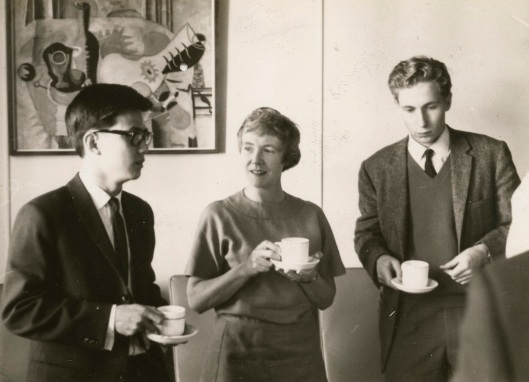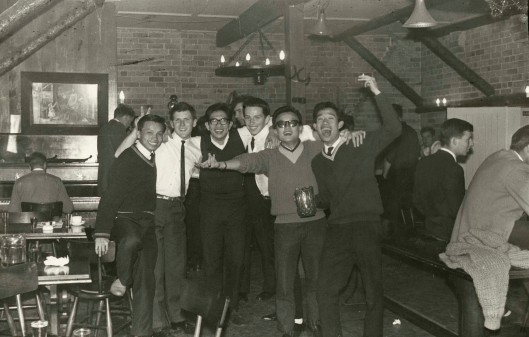Tags
1950s, 1960s, 1970s, Africa, Arana, Asia, biochemistry, Colombo Plan, international students, mineral technology, mining, Pacific, physics

Oo Khaik Cheang, Philippa Wiggins and an unidentified person at a farewell morning tea for Oo in the Department of Biochemistry, c.1964. Photograph courtesy of the Hocken Collections, Department of Biochemistry records, MS-4113/009, S14.512b.
In the middle of the twentieth century Pakeha New Zealanders, who had for generations looked “home” to Britain, became increasingly conscious that they were part of the Asia-Pacific region. The arrival of Asian students on New Zealand university campuses as part of the Colombo Plan played no small part in this changing perspective of the world.
The Colombo Plan – named for the city where it was signed, Colombo in Ceylon (now Sri Lanka) – was a 1950 agreement between various Commonwealth countries to promote economic and social development in Asia and the Pacific. There were various aspects to the scheme: more developed nations sent money and technical expertise to countries in need of assistance, and they also provided education within their own tertiary institutions for promising students from developing nations. Around 3500 students came to New Zealand as part of the Colombo Plan during the 1950s, 1960s and 1970s. This country then withdrew from that aspect of the scheme, though the Colombo Plan survives today, considerably modified from its origins of over sixty years ago.
Otago’s first Colombo Plan students arrived in the early 1950s, with numbers gradually building up. In 1965 there were just over 160 international students on campus, more than half of them from Asian countries. Probably most, if not all, of the Asian students were here on the Colombo scheme. The largest group came from the countries which would later form Malaysia: 39 from Malaya, 11 from Sabah and 8 from Sarawak. Another 10 came from Thailand, 8 from Singapore, 8 from Hong Kong, 2 from Ceylon, 2 from Indonesia, 1 from Java and 1 from Burma. A quarter of these Asian students were women. Otago also had 28 international students from Africa and 26 from the Pacific Islands that year.
The Colombo Plan students completed courses in a wide range of disciplines. Most lived in residential colleges for at least part of their course, and in recognition of this the government provided funding for the university to expand its residential capability. The money was used to extend Arana Hall (now Arana College), with its new Colombo Wing opening in 1968. But authorities were keen for the Colombo Plan students to be integrated throughout the community, so they were spread around all the colleges, and also enjoyed the hospitality of New Zealand host families during holidays.
Arrival in Dunedin, with its less than tropical climate, could be something of a shock for students from Asia! Furthermore, especially in the early years of the scheme, many New Zealanders were unaccustomed to the presence of ‘foreigners’ and treated anybody speaking in another language with suspicion. Fortunately, other members of the community made a real effort to welcome the visitors and the students themselves appreciated the opportunity to learn about Kiwi culture. Some really threw themselves into student life. One outstanding example of this is Mazlan Othman, who arrived in Dunedin in the early 1970s as an undergraduate science student and went on to become the first woman to complete a PhD in physics at Otago. She enjoyed all the capping events, attended protest rallies, played in a band, worked in a restaurant, visited the mountains and enjoyed long discussions at the pub with other students. She learned to appreciate New Zealanders’ egalitarian outlook on life.

Some of these mining students are likely to have been at Otago on the Colombo Plan – they were clearly getting into the spirit of Otago student life! Freshers’ welcome 1964, Department of Mineral Technology album, MS-3843/005, S13-561b, Hocken Collections, University of Otago.
Like many other Colombo Plan graduates, Mazlan Othman went on to a successful career. She returned to Malaysia to teach, and later worked in the Prime Minister’s office to oversee development of Malaysia’s national planetarium. She then became Director of the United Nations Office for Outer Space Affairs. Many became university lecturers in their home countries. Oo Khaik Cheang, who features in the photograph above, became Professor of Biochemistry at the University of Malaya (Kuala Lumpur). He completed a PhD on “The biosynthesis of bacterial cell wall constituents” at Otago, graduating in 1965. Others went on to signficant political careers. A well-known example is Sulaiman bin Haji Daud, who graduated in dentistry from Otago in 1962. Over many years in Malaysian politics he served as minister in various portfolios, including education and health. Soedjati Djiwandono, who studied education, politics and languages at Otago before completing post-graduate qualifications in London, became a distinguished political scientist in Indonesia.
The Colombo Plan offered the opportunity for students to complete qualifications not yet available in their home countries, and to bring the benefits of that learning to their home communities. But the plan also had great benefits for the host countries. It brought a new diversity to the student body and introduced New Zealanders to new cultures. Lifelong friendships were forged in Otago’s residential colleges, lecture theatres, labs and the student union. The scheme brought some especially bright minds to Otago, for competition for the scholarships was fierce. The connections made through the Colombo Plan would have a very long impact on the university, as the goodwill built up encouraged further generations of international students to enrol here. It is no accident that the largest group of international students at this university in more recent decades has been from Malaysia, which was also the home of the largest group of Otago Colombo Plan students.
Did you attend Otago under the Colombo Plan? If so, do you have any memories to share? Can you help identify anybody in the photographs? I have published the image of the mining students on this blog previously, but I’m yet to identify any of the people, or the location!
Update – 27 March 2014: Many thanks to Alison Finigan of the Alumni Office who found a mining graduate at an alumni function in Kuala Lumpur who identified some of the people in the mystery photograph! Among the men standing are Boon Meer Prasart (left), Vivoon Petpaichit (3rd from left), Chai ? (wearing dark glasses) and Paichit Patasorn (right). All four were from Thailand. Can you add any more details?
Another update – 16 December 2014: A big thank you to Nic MacArthur who identified Ray Soper as the man standing second from left in the photograph of mining students at their freshers’ do. Ray graduated with a BSc in 1967, a couple of years ahead of Nic, who graduated with a BSc (Hons) in mineral technology in 1969. A check of the graduation programmes also reveals what are hopefully the correct names of three of the Thai mining students. Viroon Petpaisit graduated BSc in December 1965, while Paichit Pathnopas and Sunan Boonmeeprasert were awarded Bachelors of Engineering in December 1966. I’m still wondering what the venue is – anybody out there know?
More information – 26 July 2016: My thanks to Jean Kennedy, who identified the man in dark glasses in the mining student photograph as Riew Kongsangchai, who graduated with a Bachelor of Engineering degree in December 1965. Jean became friends with the Thai mining students through the International Club in 1963 and remembers them as ‘the best cooks among the Asian students’; they shared a flat in Clyde Street.

